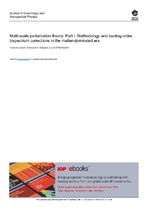| dc.contributor.author | Clarksona, Chris | |
| dc.contributor.author | Gallagher, Christopher S. | |
| dc.contributor.author | Clifton, Timothy | |
| dc.date.accessioned | 2021-02-18T11:24:24Z | |
| dc.date.available | 2021-02-18T11:24:24Z | |
| dc.date.issued | 2020 | |
| dc.identifier.citation | Clarksona, C. et al. (2020). Multi-scale perturbation theory. Part I. Methodology and leading-order bispectrum corrections in the matter-dominated era. Journal of Cosmology and Astroparticle Physics ,2020(03) | en_US |
| dc.identifier.uri | http://doi.org/10.1088/1475-7516/2020/03/011 | |
| dc.identifier.uri | http://hdl.handle.net/10566/5958 | |
| dc.description.abstract | Two-parameter perturbation theory is a scheme tailor-made to consistently include nonlinear density contrasts on small scales (< 100 Mpc), whilst retaining a traditional
approach to cosmological perturbations in the long-wavelength universe. In this paper we
study the solutions that arise from this theory in a spatially-flat dust-filled cosmology, and
what these imply for the bispectrum of matter. This is achieved by using Newtonian perturbation theory to model the gravitational fields of nonlinear structures in the quasi-linear
regime, and then using the resulting solutions as source terms for the cosmological equations.
We find that our approach results in the leading-order part of the cosmological gravitational
potentials being identical to those that result from standard cosmological perturbation theory
at second-order, while the dark matter bispectrum itself yields some differences on Hubble
scales. This demonstrates that our approach is sufficient to capture most leading-order relativistic effects, but within a framework that is far easier to generalize. We expect this latter
property to be particularly useful for calculating leading-order relativistic corrections to the
matter power spectrum, as well as for deriving predictions for relativistic effects in alternative
theories of gravity. | en_US |
| dc.language.iso | en | en_US |
| dc.publisher | IOP Publishing Ltd | en_US |
| dc.subject | Cosmological perturbation theory | en_US |
| dc.subject | Gravity | en_US |
| dc.subject | Non-gaussianity | en_US |
| dc.subject | Power spectrum | en_US |
| dc.subject | Nonlinear density | en_US |
| dc.title | Multi-scale perturbation theory. Part I. Methodology and leading-order bispectrum corrections in the matter-dominated era | en_US |
| dc.type | Article | en_US |

